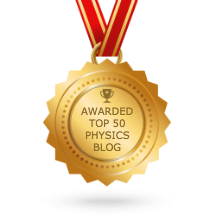Intermediate Physics for Medicine and Biology doesn’t analyze diffraction. It’s mentioned a few times—in the chapters about images (Chap. 12), sound (Chap. 13), and light (Chap. 14)—but it’s never investigated in detail. In this post, I want to take a deeper dive into diffraction. In particular, we will examine a specific example that highlights many features of this effect: diffraction from a knife edge.
Assume a plane wave of light, with intensity I0 and wavelength λ, is incident on a half-infinite opaque screen (the knife edge, shown below with the incident light coming from the bottom upwards). If optics were entirely geometrical (light traveling in straight lines with no effect of its wavelength) the screen would cast a sharp shadow. All the light for x < 0 would continue propagating upward (in the y direction) while all the light for x > 0 would be blocked. But that’s not what really happens. Instead, light diffracts off the screen, causing fringes to appear in the region x < 0, and some light entering the shadow region of x > 0.
 |
| Optics, by Hecht and Zajac. |
If we solve for the intensity distribution beyond the screen (y > 0), we get
This is an interesting function. When I first saw this solution plotted, I noticed oscillations on the left (x < 0) but none in the shadow region on the right (x > 0).
But C and S are both odd, so they oscillate on the right and left. The middle two panels in the figure above show how this happens. Taking one half minus C and one half minus S just flips the two functions and adds a constant, so the functions vary from roughly zero to one instead of minus a half to plus a half. When you square these functions, the oscillations that are nearly equal to zero get really small (a small number like one tenth, when squared, gets very small) while the oscillations that are nearly equal to one are preserved (one squared is just one). There are still some small oscillations in the shadow region (x > 0), but somehow when you add the cosine and sine parts even they go away, and you end up with the classic solution in the bottom panel, which you see in all the textbooks.
I was curious to know is how this function behaves for different wavelengths. Diffraction effects are most important for long wavelengths, but for short wavelengths you expect to recover plain old geometrical optics. Interestingly, the wavelength λ only appears as a scaling factor for x in our solution. So changing λ merely stretches or contracts the function along the x axis. The figure below shows the solution for three different wavelengths. Note that the argument of the Fresnel sine and cosine functions is dimensionless: x has units of distance, but so do the wavelength λ and the distance past the opaque screen y, and they appear as a product under a square root. Therefore, we don’t need to worry about the units of x, y, and λ. As long as we use consistent units we are fine. As the wavelength gets small, the distribution gets crowded together close to x = 0. The red curve is the geometrical optics limit (λ = 0). The case of λ = 0.1 approaches this limit in a funny way. The amplitude of the oscillations does not change, but they fall off more quickly, so they basically only exist very near the knife edge. You wouldn’t notice them unless you looked with very fine spatial resolution. The intensity does seep into the shadow regions, and this is more pronounced at large wavelengths than at small.
The picture above was plotted for one distance, y = 1. It’s what you would get if you put a projector screen just behind the knife edge so you could observe the intensity pattern there. What happens if you move the screen farther back (increase y). Since y and λ enter our solution only as their product, changing y is much like changing λ. Below is a plot of intensity versus x at three different values of y, for a single wavelength. Making this plot was simple: I just changed the labels on the previous plot from λ to y, and from y to λ. As you get farther way (y gets larger), the distribution spreads out. But the spreading is not linear. Because of that square root, the spreading slows down (but never stops) at large y.
You can see the full pattern of intensity in the color plots below. Remember, x is horizontal and the opaque screen is on the right, y is vertical and opaque screen is at the bottom, and color indicates intensity. Yellow is the incident intensity I0, and blue is zero intensity (darkness). The geometrical limit would be a strip of blue on the right (the shadow) and yellow on the left (the unobstructed incident wave). The case for λ = 0.01 closely approximates this. The case of a really long wavelength (λ = 100) is interesting. The light spreads out all over, giving more of a uniform distribution. For long wavelengths, the light “bends” around the opaque screen. This is why you can still hear music even if there is an obstacle between you and the band. The sound wave diffracts because of its long wavelength (especially the low pitched notes).Diffraction is fascinating, but it’s a bit too complicated to be included in IPMB. Nevertheless, it’s a part of the physics behind visual acuity, microscope resolution, ultrasound transducers, and many other applications.















